Despite trying (what feels like) every productivity method on Earth — time-blocking, getting things done, improving your focus — many days, your to-do list feels like a Sisyphus’ climb. 😣
On the cusp of burnout, you realize you’re one tiny human and can only do so much. So you think you should delegate — you’ll become more efficient, have more time to rest, and enjoy doing the tasks on your plate. What’s not to like?
You begin and quickly learn outsourcing is no cakewalk. Finding the right people to delegate, training them to excel, and preventing micromanaging is profusely overwhelming. But with the right tools and methods under your belt, it doesn’t have to be.
Here, I’ll share the ins and outs of delegation — why you should consider it, how to outsource effectively, and mistakes you should avoid.
And the advice here isn’t in a silo: I’ve interviewed 11 leaders from across domains who’ve been there, done that to show us all the way.
First things first, what is delegation?
There’s no universal definition of delegation because so much of it is context-dependent.
Simply put, delegation is when you outsource a task on your to-do list to someone else — giving them the full responsibility and authority to complete that job.
Delegation can look like:
- Transferring the execution of a big project at work to a colleague or team member
- Hiring a virtual assistant to complete administrative tasks
- Employing a house cleaner to tidy up your space
As is evident from the examples above, delegation is a vast field. It can be outsourcing something minuscule or a huge undertaking, and it can be in your personal or professional life.
What delegation doesn’t mean
With such a broad definition of delegation, there’s a possibility of misunderstanding what constitutes delegation and what doesn’t fall in its realm.
Here’s a list of what delegation doesn’t mean:
- Delegation isn’t relinquishing your commitment. Even if your coworker is responsible for completing a task, you help them when needed and ensure they have all the necessary resources to excel at their job. Delegation isn’t hand-off and run — be available to answer questions and steer your team in the right direction.
- Delegation isn’t dumping responsibilities on someone else. Be mindful of your team’s capacity while delegating. It isn’t productive to free up your to-do list only to overburden someone else’s.
- Delegation isn’t micromanaging. When you delegate a task, you have to shed control over how it gets completed. Being available to help doesn’t mean you’re constantly peeping on how someone does the job. This doesn’t mean that you’re completely oblivious, but that you provide your team members freedom and breathing room.
Are you ready to delegate? Watch out for these 5 warning signs
When I asked Hailley Griffis, Head of Communications and Content at Buffer, the one piece of advice she’d give her former self, she said: “Delegate earlier than you think you’re ready.”
So don’t wait till you’re on the throne of burnout to begin delegating. Here are five red flags you should watch out for. 🚩
- You haven’t left work on time for a while. Long hours are the easiest telltale signs of hoarding too much work.
- You often feel like you’re the only one that cares. Feeling like no one on your team — except you — cares about a project is one of the early pre-indications that you need to delegate some responsibilities. (It can also build resentment toward your colleagues, which does no one any good.)
- You often find your competent team members saying, “I can help you with that.” If your coworkers often raise their hands to take on more, it might be an indication that they feel underwhelmed by their current role and want to make a more significant impact.
- You’re queasy to take a day off because you know things will fall apart without you. Whether it’s at home or in the workplace, if you feel like you can’t take a day to rest, it’s a danger sign to delegate more. In most cases, things should be able to move smoothly (at least for a day or two) even if you don’t intervene.
- Your to-do list has tasks that you keep procrastinating on. Are certain pesky tasks haunting you because you keep moving them from today to tomorrow? It might be a sign that you need some help in finishing them.
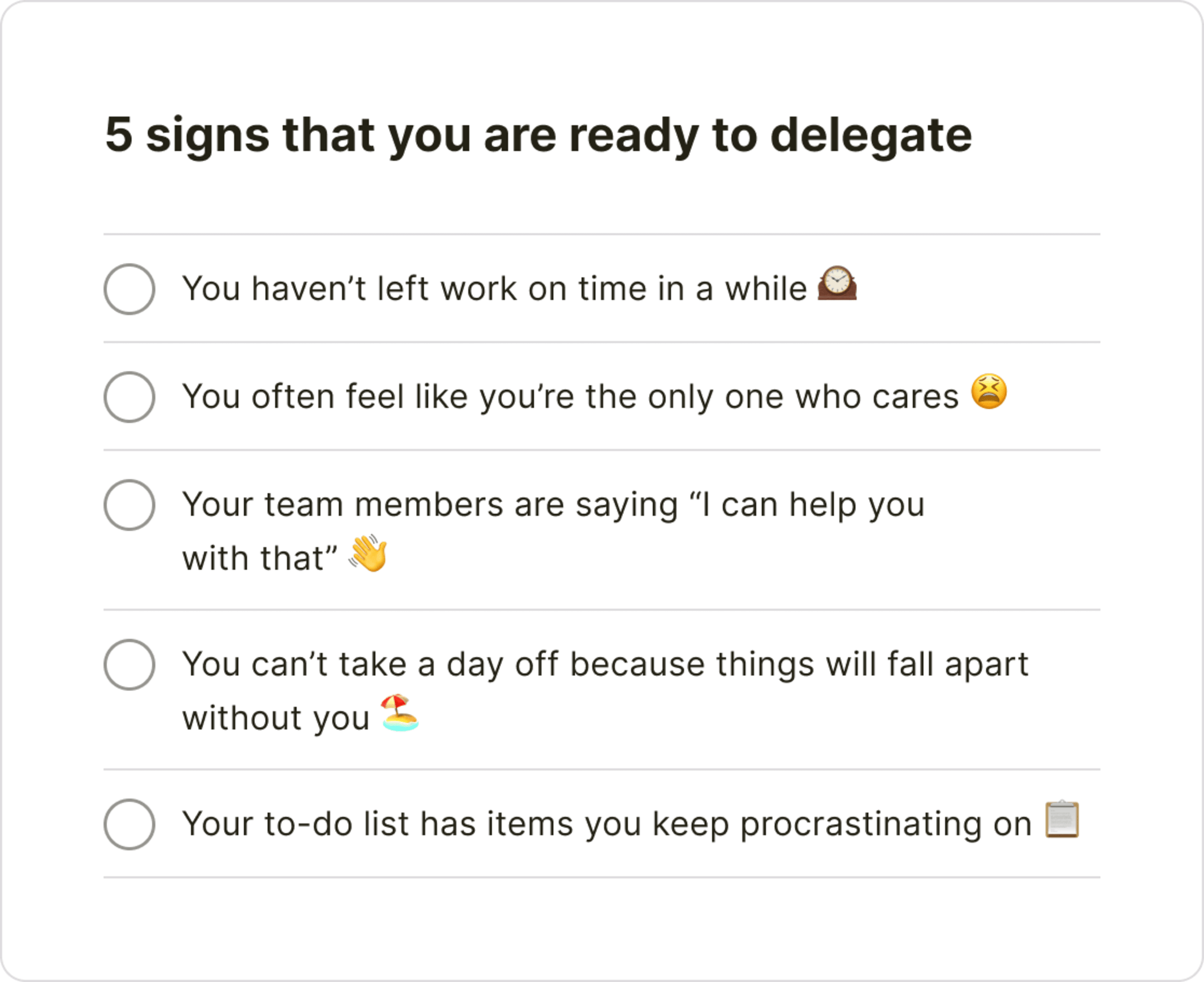
Why should you outsource a task you can do yourself? 5 benefits of delegation
Even after recognizing your behavior in some of the signs above, you might think, “It’s just easier and quicker to do it myself.” In the short-term, that may also be true.
But what about the long-term? Being the only one who knows how to do certain tasks is unsustainable for a team's productivity. Yes, your teammates might make mistakes or take longer initially, but they’ll quickly adapt and learn — freeing you to do the tasks you enjoy and excel at. Delegation is an investment to free up your mental space in the future.
Below are five more benefits of delegation — which prove it can massively improve your (and your team’s) productivity.
Benefit 1: You save time and energy by shortening your to-do list
When you delegate, you still have to do the legwork of guiding your teammates, allocating resources, and providing support. Still, the work is significantly trimmed from when you did everything yourself.
Let’s say you’re pondering whether you should outsource maintaining your lawn to a professional gardener. You think you can make time for trimmings and repotting your plants over the evenings. But spending your non-work time gardening takes away from the time you could’ve spent resting, playing with your kids, or indulging in a hobby. You’re always making significant trade-offs if you try doing everything yourself.
And you might even think you’re doing just fine managing everything. But it can be hard to see how much you’re nibbling on little tasks — that you can easily outsource — when you’re in the thick of your to-do list. Hear it from Elise Darma, a Social Media Educator for Small Businesses:
“I’ve burned out twice in my entrepreneurial career. The second time, my team really took the reins and ran a launch almost totally without me! That experience was a wake-up call for me in a lot of ways, including seeing where I could remove some of the pressure I had been putting on myself.”
It isn’t all talk. Data says it too: 72% of leaders under age 35 say they feel used up at the end of every day, according to DDI’s latest Global Leadership Forecast Report.
For leaders, delegation is critical to avoid burnout and put their best foot forward.
However, remain prepared for the complicated emotions that come along with the relief of shortening your to-do list. Fio Dossetto, a senior content strategist and author of the contentfolks newsletter, shared her biggest struggle was getting comfortable with the lack of control that’s the part-and-parcel of delegating.
“It doesn't matter if I can actually do it. The question is, should I be doing this? Is this the right use of my time? Am I serving the company, the team, and the customer in the right way if I focus on doing this? If the answer is yes, then I can do it. But if the answer is maybe not, because there are these other three things that are more impactful or larger or more useful, then this is a good task for delegation.”
So the key here is knowing the tasks you should do — because you can do everything if it were up to you.
Benefit 2: Your colleagues are happier because you trust them
Delegation is a way of (metaphorically) saying, “I trust you,” because when you’re taking out the tasks from your to-do list, you’re trusting someone else on your team can do it just as well — if not better. It not only empowers your team members, but keeps them happy.
“As I've delegated responsibilities, tasks, and projects to my team, I've seen them feel more ‘in the know’ on important initiatives, empowered to share their perspectives, and have a pivotal role in driving our company's business outcomes — all of which boost employee morale. Delegation also helps my team members grow their careers by enabling them to build their personal brand across the company,”
Griffis (Buffer) agrees. She adds that delegating tasks often also gives you an opportunity to improve your team’s competence — especially if your team members are craving to grow out of their comfort zone.
“Knowing a teammate is looking to level up can be a good opportunity to delegate but also help that teammate grow in a new area by delegating a more complex or crucial task.”
What if you fear your way is the best way and no one else can match? 😬
Releasing control over how something gets done is perhaps one of the biggest battles you’ll fight when delegating. But remember, if you don’t trust your team with execution, you not only squash their confidence, but also let the supposedly outsourced task occupy your headspace. It’s a lose-lose scenario.
“It's important to remember that just because you do things a certain way, that doesn't make that way right or the most efficient. You have to trust your team to execute and excel,”
If your emotional battle is the opposite — coming across as too intense or overburdening someone — you’re not alone. Diana Briceño, Head of Content at VEED, was in a similar boat. She battled an internal me vs. me fight where she worried she was coming across too intense. Her solution? Open and honest communication.
“I figured if I let my team see this more human side of me as their manager, then it could help us all drop our guards a bit and have a real conversation on how we can best show up for each other professionally.”
The bottom line is that the shared benefit of collaboration only comes to fruition when you avoid micromanaging and communicate with honesty & empathy.
Benefit 3: Each task gets done with better focus and attention to detail
When you outsource tasks, you get more time and energy to dedicate to what remains on your plate. And the job you’ve delegated also gets done with more care.
John Doherty, founder of EditorNinja, says this is one of the most significant benefits he witnessed in his workflow.
“By delegating to someone else, the task or job ends up being more effective, because they are able to give that task more time. If I have 10 tasks divided between my finite hours, each only gets 10% of my effort. But if I give it to someone else, they can put 3-5x the amount of time into it.”
💡 Remember: It’s better to do one task with excellence than to do five tasks poorly.
Benefit 4: You find better ways to do the same ol’ things
You might think your way of completing a chore is the most efficient one. But once you hand over the reins to someone else, you find multiple ways to do the same thing — some of which might be more productive.
“When you give others more responsibility, they find ways to improve tasks, flows, and processes — and that helps the entire team,” says Steven Macdonald, Head of Content at INEVO.
Sometimes, you’re too close to a project to see how you can improve the processes. Other times, you do things a certain way just because that’s the way it’s always been done. Delegating allows you to broaden your horizons and bring fresh perspectives and methods to the table.
Benefit 5: You’re able to focus on tasks that you enjoy and that create the highest impact
Everyone’s to-do list has certain items that require deep work and drive the most impact. And then there are other tasks that are essential, but taxing — maybe because you’ve outgrown them or perhaps because you find them tedious.
When you spend a lot of time and energy on low-impact tasks, you take away from your potential and hinder your growth. You should spend the majority of your time in the areas you seek mastery in.
Dani Stewart, Content Lead at ConvertKit, says she also procrastinates less due to delegation. Because now, the work scheduled for the day energizes her.
“There have been many tasks in my past that I would put off until the last second because it felt like a big context switch or I had just been doing it for so long and was ready for a change. Being able to delegate these tasks has made me even more excited to do the work that I already love.”
When you delegate, you see the benefit of honing your expertise and being excited by your responsibilities.
How to delegate effectively in 4 steps
The advantages of delegation are enough to convince you to outsource. But where do you even begin? How do you choose the right people? How do you provide feedback without micromanaging?
Below is a step-by-step guide on how to delegate effectively without any friction.
Step 1: Decide what you want to delegate
Deciding which tasks you should delegate becomes easier once you know which ones you shouldn’t. Some of it will be obvious — like reporting to your manager or choosing a birthday present for your friend.
But other tasks might be more nuanced. For instance, for John Bonini, a leading B2B consultant, picking up his kids from school is non-negotiable. He wants to spend that time with his children to bond with them. So outsourcing this is out of the question. Similarly, for Darma (social media educator), outsourcing anything that centers or surrounds her personal brand — like filming a YouTube video or giving a presentation at an event — isn’t possible.
Initially, you might be tempted to delegate something you actually enjoy doing just because it’s possible to outsource it. But you shouldn’t outsource what you love to do, according to Doherty (EditorNinja):
“The most common mistake I see people make when they start delegating is delegating things that they love, and keeping things that they dislike! The approach should be flipped — delegate the things you hate that others love, and keep the things you love.”
He adds, “This is not selfish!”
So if cleaning sparks joy for you, like it does for me 🙋♀️, don’t tidy it away from your to-do list.
Once you know what you can’t delegate, you’re left with a list of tasks you can delegate. But you can’t hand off all these tasks at once. Here’s where the passion-competence delegation matrix comes in handy to understand what you should begin with.
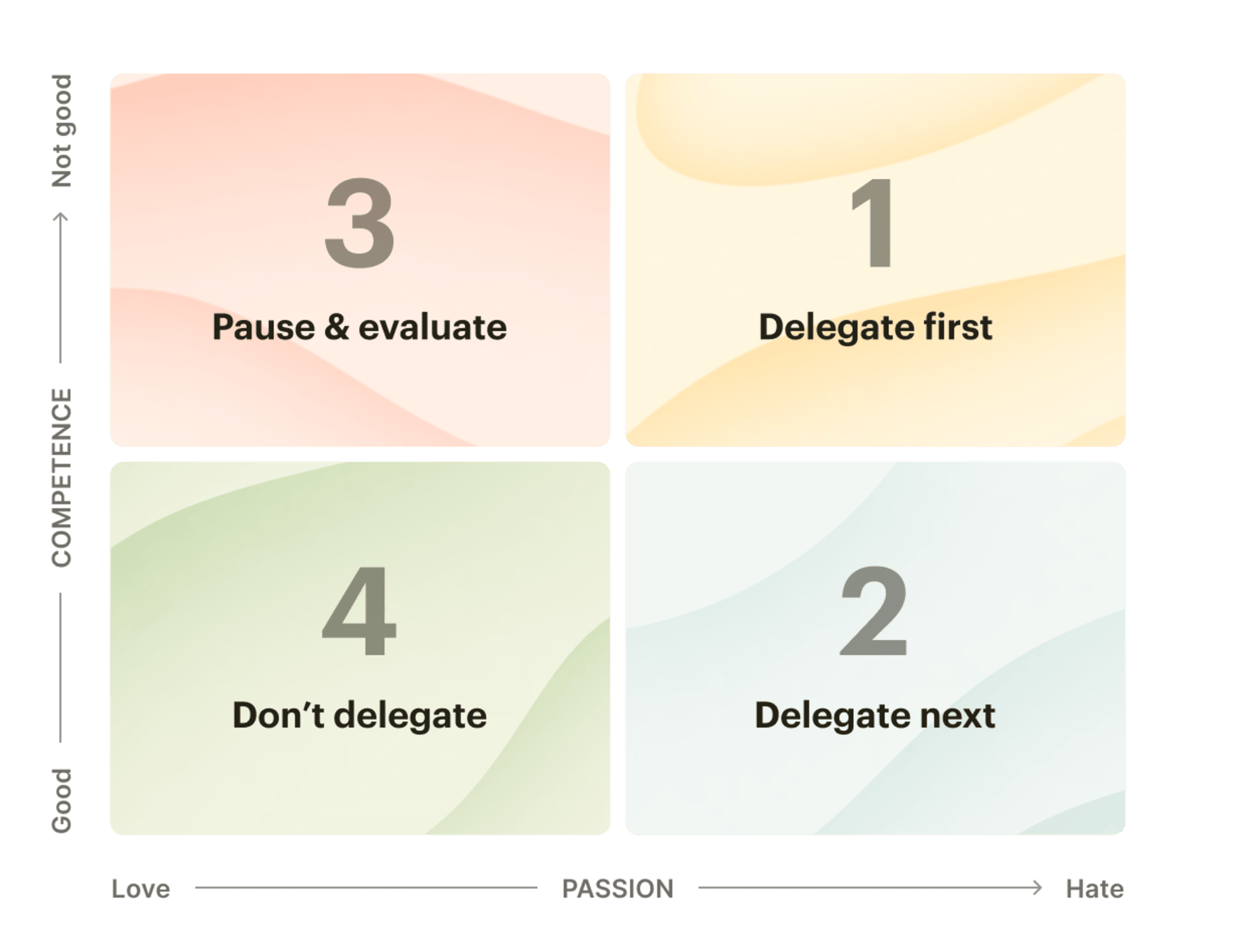
- Low passion, Low competence: These are things you don’t enjoy doing and don’t excel at — outsource these first.
- Low passion, High competence: These are the tasks you are A+ in, but you are no longer excited about completing them — delegate these second.
- High passion, Low competence: These are jobs you enjoy doing, but unfortunately aren’t good at — hand-off these in the third round. These tasks can be hard to let go of, but if you can’t develop the competence or don’t have the time to master them, it’s best to outsource these tasks to an expert.
- High passion, High competence: These are the tasks you’ve mastered and love doing — ideally, you’d never delegate them. But you should consider outsourcing some low-leverage tasks here, too, if many jobs fall under this category.
⚡Pro-tip: Take this self-assessment quiz to identify the low-value tasks in your workflow.
Step 2: Choosing the right people to delegate to
After you’ve landed on the tasks you want to delegate, your next job is figuring out who will take those responsibilities.
Across all the experts I interviewed, the suggestion were similar: Delegate to someone whose role overlaps with the responsibility and who wants to grow in that area. Briceño (VEED) illustrates this with an analogy:
“Think of a content team as a shopping mall. The head of content is responsible for planning and making sure the entire mall has buy-in from stakeholders so we can build a mall with stores attractive to our target audience and a layout that encourages people to explore and buy.
However, the head of content isn’t personally managing the daily operations of every single “store” themselves (or else they would never be efficient enough to get a return on their investment). Different teammates own different stores in the mall and they’re responsible for their store’s operations and keeping them stocked with the right inventory.”
Tracey Wallace, Director of Content Strategy at Klaviyo and founder of Contentment, adds to it and recommends updating the job description (JD) of an employee if they’re now handling responsibilities that weren’t present in their JD earlier:
“Don't be afraid to alter or edit JDs to reflect changes in the business and resulting changes in your team's deliverables. JDs are contracts between the company and the employee –– and if something is now on their plate that wasn't before agreed upon, update that. This helps the employee feel more in control of their career and tasks, and makes it easier for you to give a performance review based on work done in the current JD.”
When it’s not easy to decipher who’d be the best person for a job, the willingness-capability delegation matrix by Chris Allen (Editor of Management Matters) comes in handy.

- High Willingness, High Capability: If someone has both — the desire to take on extra tasks and the skillset to accomplish them — delegating the job to them is a no-brainer.
- High Willingness, Low Capability: When you delegate to someone eager to learn but not equipped with the skills for a job, stay mentally prepared for training them in the beginning and supporting them throughout. The best tasks for this quadrant are the recurring responsibilities you want to outsource for the long-term.
- Low Willingness, Low Capability: Talked to someone who seemed uninterested in taking on an extra challenge and lacked the necessary experience to complete the job? Don’t delegate to them — it can get messy and build resentment.
- Low Willingness, High Capability: These are people you can delegate to — their skillset fits the responsibility. But they aren’t excited to take on the task. Chris Allen recommends asking these people to train and monitor the people in “High Willingness, Low Capability.” This way, no one takes on a chore they feel meh about.
Another thing to remember is the difference between delegating authority and delegating responsibility. The former means you hand over the permission to make decisions to move the project along. The latter is you ask someone to complete the job for you, but you still call the shots and require any decisions to run by you.
You can delegate both authority and responsibility. Or you can only delegate responsibility, but claim authority — it depends on the nature of the task and the skillset of the person you’re outsourcing to. Ryan Prior, Head of Marketing at Modash, says that’s a trade-off you have to decide:
“Do you pay more for an experienced person to clear the entire thing from your plate, or pay less for a less experienced person & accept you'll still need to be involved to some extent? There's no universal right answer — just keep this in mind when hiring & delegating.”
Step 3: Setting up systems, resources, and expectations to help your team succeed
The advice to prepare resources and processes before delegating echoed across almost all leaders I interviewed. You can’t throw someone in the deep end and expect them to learn how to swim on their own without any guidance.
Dossetto (contentfolks), says this can be the source of annoyance for delegators:
“[Bad delegators] kind of expect people to read their mind and therefore become frustrated when the deliverable doesn't meet the standard they have in their own head.”
Her solution? Being crystal clear about your expectations:
“What has helped me is being very specific and deliberate in my request and painting a clear picture of what I need in terms of quality. The quality means the depth, the level of detail, the level of polish, etc. […] This way, the person on the receiving end of the task understands the role they're playing and is very clear on the expectations — reducing a lot of back and forth and rework.”
Aim not to leave anyone questioning how to complete a task. Remember: What’s obvious to you might not be straightforward for someone else. Next time you do a job that you’ll delegate in the future, note down all the mini-tasks you do and the documents you open to complete the job. This will minimize the chances of you missing sharing an important resource or guidelines when handing off the responsibility.
Wallace (Klaviyo), says your ultimate goal should be to become an invisible boss:
“An old boss once told me that the best bosses are invisible. It's important that your team be so well organized that your larger organization knows who exactly to go to on your team, bypassing you, to get certain tasks done. When larger projects come across the team's plate, you can certainly delegate, but you want it to be clear to the other teams who on your team does what, in what order, so that they know who to work with, when, and for what.”
Make it a goal to set responsibilities and expectations so clearly that things run smoothly without requiring management. The mental load that you’ll put off when that happens is priceless.
You want everyone on your team to know not just the task they’re supposed to complete, but also:
- How to escalate roadblocks or risks and ask for support
- All the timelines and due dates related to the project
- Where they can find documents related to their job
The problem is as your team grows or your responsibilities become more complicated, delegating doesn’t remain so straightforward. You want to delegate execution to one person but need a senior person to direct them. Or you’re looking to hand off an important job to a junior employee but need them to take inputs from the whole team.
In these scenarios, refer to the matrix of Joseph Flahiff, author of Being Agile in a Waterfall World.
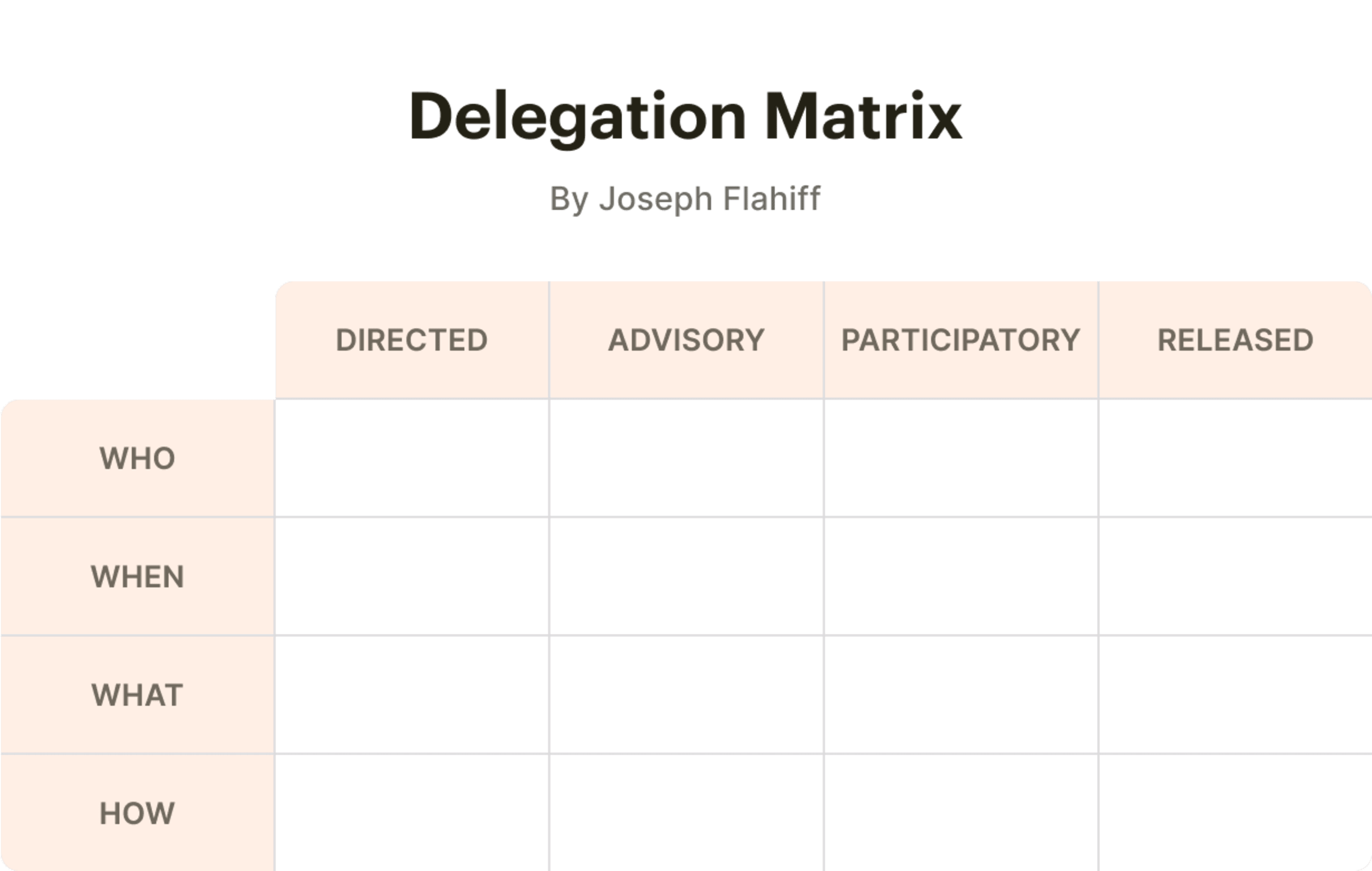
The columns are simple enough. They display who, when, what, and how of a task.
The rows are your room for nuance:
- Directed is when you take the decision alone and lead the orchestra of delegation.
- Advisory is when you seek inputs from your team, but you still have the ownership to make the final call.
- Participatory is when your opinion has the same value as everyone else’s. Majority wins.
- Released is when you delegate the delegation and hand off the responsibility and the authority entirely to someone else.
Let’s say you have a big project to outsource.
- You know the person (the “who”) you want to delegate to [directed].
- You trust them to own it (the “how”) completely [released].
- But you want your team’s input on timelines (the “when”) — although you’ll have the deciding vote [advisory].
- And you need the whole team involved to map out the tasks (the “what”) of the project [participatory].
In the matrix, your position looks something like this:
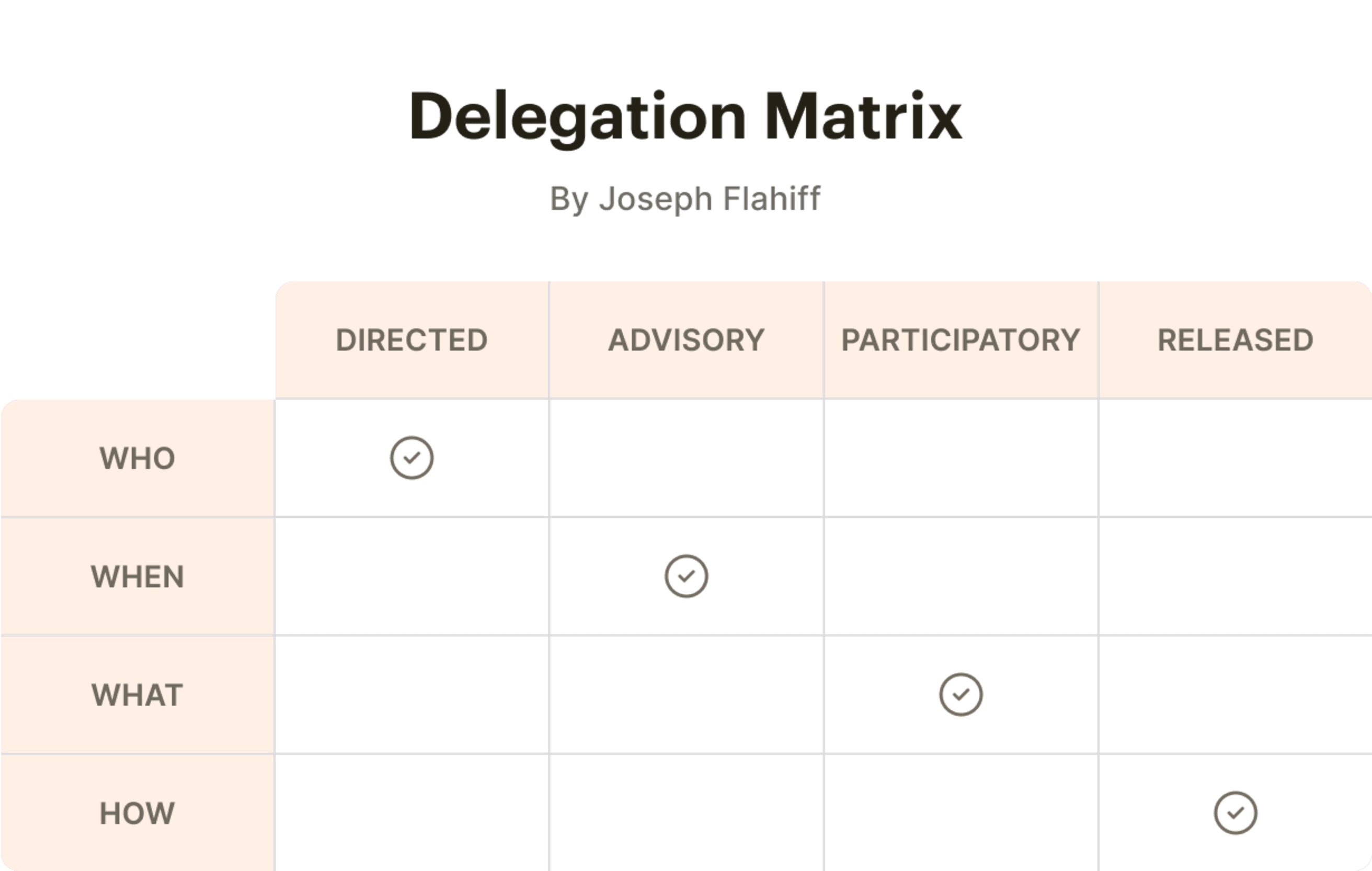
Flahiff’s matrix is perfect for leaders who are delegating projects in their entirety to large teams with varying levels of responsibility. You can also use it for tasks where the authority and responsibility aren’t distributed evenly, and you need something more nuanced to make a decision.
Step 4: Provide feedback and ask for it too
Giving feedback is often a huge undertaking for leaders because it’s time-consuming, emotionally difficult, and requires confrontation. You don’t want to upset your team members and sometimes it’s just easier to correct the errors yourself.
But when you hold back feedback, you restrict your team member’s growth. Not only will you keep reworking their slips, but you’ll also build a sourness toward them because they keep making the same mistake repeatedly — when they don’t know they’re making a mistake in the first place.
Regular check-ins and radical candor are necessary to truly delegate a task. Your colleague won’t likely nail it on the first go, and you shouldn’t expect them to. But you should proactively note down the areas of improvement and errors so they can keep excelling as they go.
The reverse is also true: When you first start delegating, you’ll likely make mistakes. Your coworkers will know areas where you can do better — maybe by adding an extra resource, creating a walkthrough of the process, or by being more available to answer queries. Asking them these questions encourages you to refine your workflows and make delegating a friction-free experience for both parties.
Prior (Modash) adds that regular feedback can also help you determine if delegating has become a lost cause:
“If you delegate something to a person & the outcome isn't good enough, usually step one (and two, and three) is to give useful feedback, clearer instructions (and so on). But it's difficult to figure out where the line is. How much more time do I have to invest in trying to delegate this thing? More feedback? At what point does it just make sense to give up & either stop doing the thing, take it back myself, or try again with someone else?”
When you regularly reflect on how the delegation process is going, you also give yourself room to evaluate if the outsourcing is going as well as you had hoped.
If not, you can determine your next steps: What needs to change for this to become successful? If the problem area is the person, maybe you need to delegate to another teammate. If it’s your micromanaging habit, perhaps you need to take your foot off the gas for a bit and check if things are working smoothly.
Ultimately, your goal is for these check-ins to become less and less frequent. You delegate a task, everyone fulfills their responsibilities without any hiccups, and the engine keeps running.
Delegation in Todoist
Productivity tools can aid your delegation efforts by creating accountability, fostering communication, and establishing a home for all tasks.
In Todoist, for example, there are workspaces to organize your projects — to keep your personal and professional life separate or to designate different places for different projects. You can collaborate with people in every workspace you create and choose the level of access for each individual.
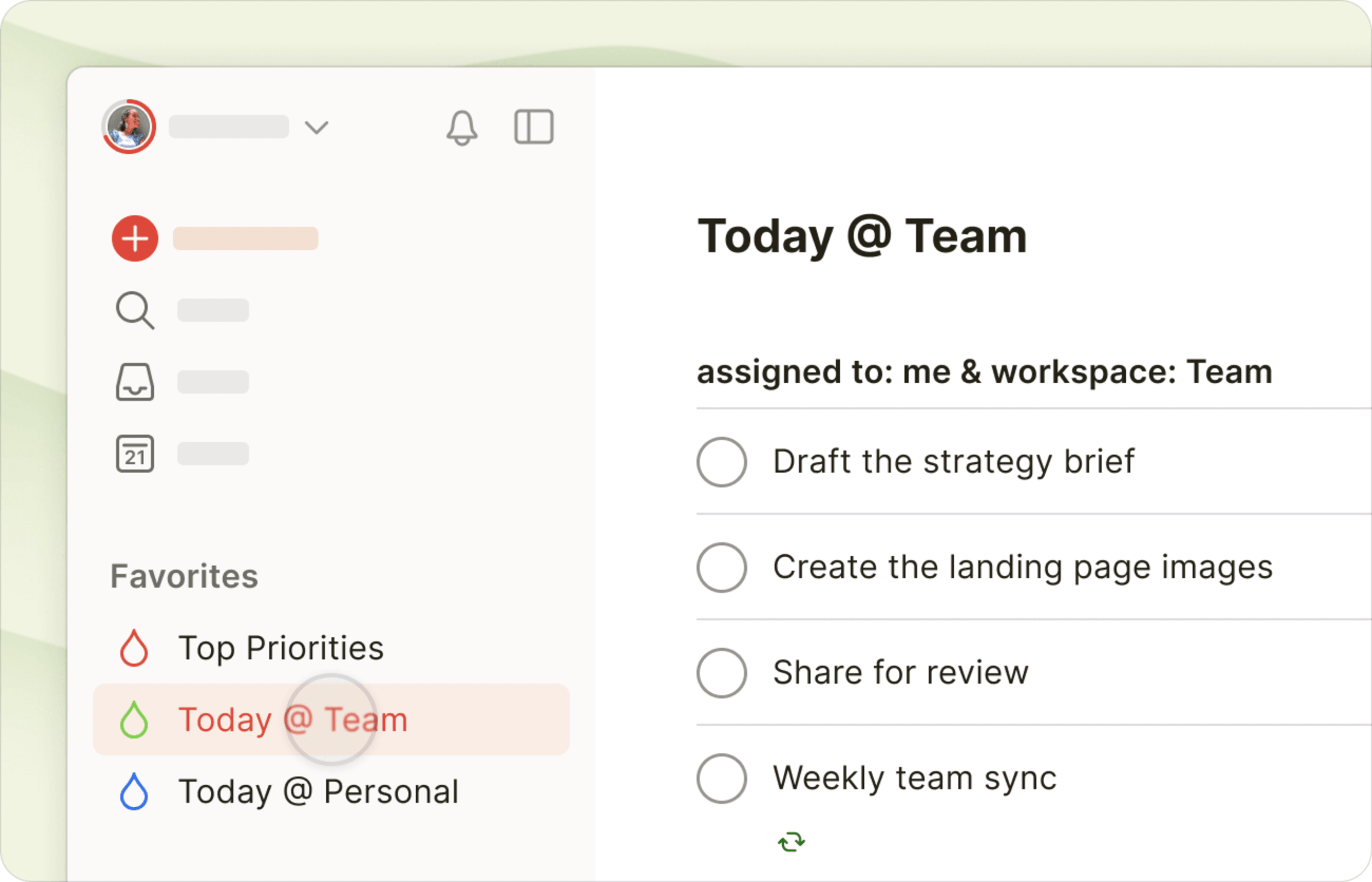
For tasks that are solely your responsibility and aren’t fit for any shared workspace, Todoist has a “personal” workspace to store all your individual jobs in private.
But this isn’t even the best part: In the Inbox and Upcoming section of your Todoist app, all your tasks are collated from every workspace — personal, team, or anything else. Accurately planning and prioritizing your personal and professional time becomes so much simpler.
When you’re collaborating with team members on a complex project, Todoist has Boards to visualize everything clearly. Here, you can assign tasks to team members and add timelines via due dates — helping keep everyone accountable.
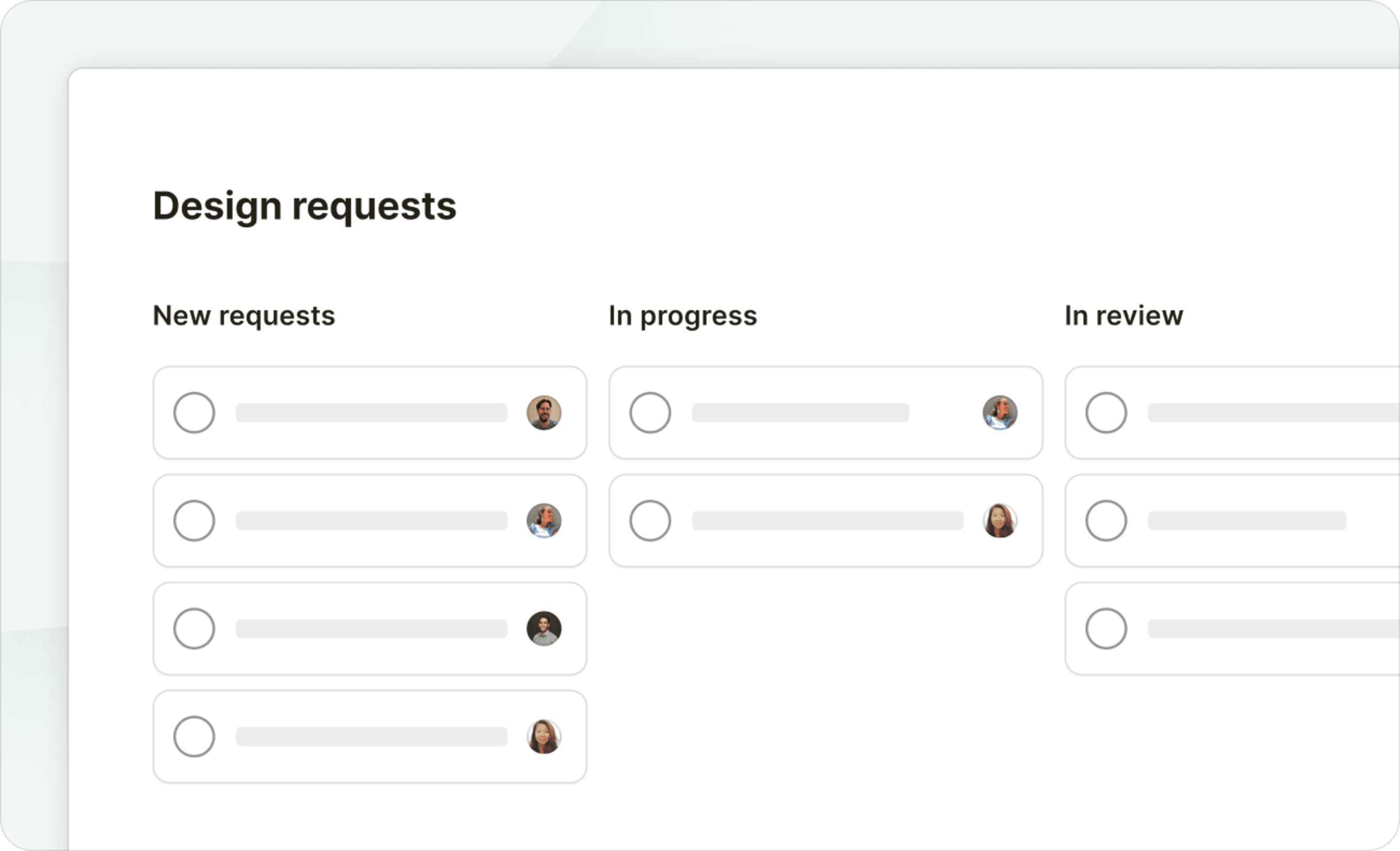
To make things even smoother, assign each task a Priority (1 – 4) to help your team instantly understand which are the most pressing jobs. Your colleagues can ask any follow-up questions, share related files, or update progress by commenting within each task.

The best part is collaboration in Todoist eliminates the need for communication to be synchronous and heavy-handed. Want to attach a file? Easy. A huge task looks daunting? Use the AI assistant to break it down to sub-tasks. Need to say a few notes? Record an audio comment.

Delegation is a science with a dollop of art
The trickiest part about delegation is that it's part-science and part-art. You can ace every step of the way, but you’ll still have to rely on your leader’s intuition a little bit to determine the right people, areas where you need to provide support, and when to let go of control.
For instance, you might know logically that a colleague’s skills don’t align with a task (and they might agree!), but your experience and interactions tell you they’re ready for the challenge. Or you may understand in theory that you need to avoid hand-holding for teaching a job, but you know a specific team member thrives when they get a lot of support. In these scenarios, rely on your gut to take the call.
Sometimes, it can also seem like delegation adds more tasks to your plate than it removes. And in the beginning, that might be true. But collaborating is a long game — you have to invest in it now to see compounding returns in the future. So take a dip in the water today and you’ll eventually learn to swim!

